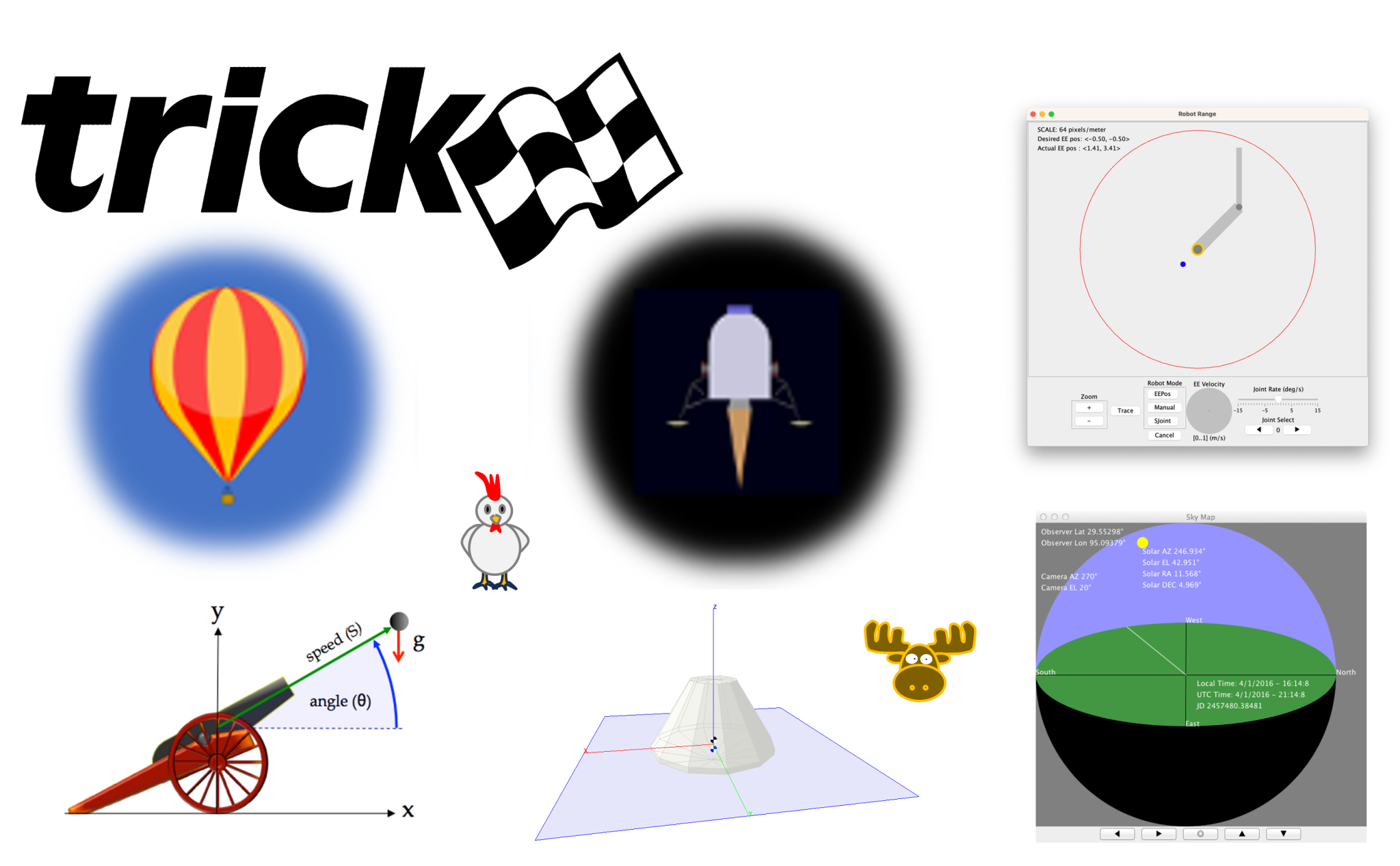The Simulation and Graphics Branch produces several software tools to facilitate building and operating simulations. Many of these are available to download and are linked below.
The Trick Simulation Environment provides a common set of simulation capabilities that allow domain experts to concentrate on domain-specific models rather than simulation-specific functions like job ordering, input file processing, or data recording. Trick’s flexible feature set enables users to build applications for all phases of space vehicle development including early vehicle design and performance evaluation, flight software development and testing, flight vehicle dynamic loads analysis, and virtual and hardware-in-the-loop training.
The General-Use Nodal Network Solver (GUNNS) is a tool that combines nodal analysis and the hydraulic-electric analogy to simulate fluid, electrical, and thermal flow systems. It was developed to create medium-fidelity, real-time simulations for crew and flight controller training, and its ability to rapidly model complex integrated systems make it an ideal systems engineering tool: enabling detailed concept comparisons; facilitating requirement and design change impact assessments; and providing realistic environments for testing developmental flight software, high fidelity component and subsystem models, and prototype, developmental, and certification subsystem hardware. It includes core run-time models and code as well as graphical user interfaces for network design and run-time analysis.
The TrickHLA software supports the IEEE-1516 High Level Architecture (HLA) simulation interoperability standard for the Trick Simulation Environment. The TrickHLA software abstracts away the details of using HLA, allowing the user to concentrate on the simulation and not worry about having to be an HLA distributed simulation expert. The TrickHLA software is data driven and provides a simple Application Programming Interface (API) making it relatively easy to take an existing Trick simulation and make it a HLA distributed simulation.
A Functional Mockup Interface (FMI) Standard Implementation for Trick Base Models and Simulations. FMI standard was developed in partnership with governmental, academic and commercial entities in the European Union. This standard is used to support the exchange of component models for complex system simulations throughout Europe and the United States. Trick simulations are used all across NASA for simulations that support human spaceflight activities. However, until now, there were no means to use FMI based models in a Trick based simulation or a method for providing Trick based models that were FMI compliant. This software provides implementation software to do both.
TrickCFS is a software package that provides the C structs, C++ classes and pertinent code required to synchronize a core Flight Software (cFS) system with the Trick simulation executive. It also provides the capability to include cFS-based application (App) data structures for generating the Trick interface code required to peek and poke cFS App data.
IDF is a software library that provides an infrastructure for interfacing software with physical input devices. Examples of common devices include hand controllers, joysticks, foot pedals, computer mice, game controllers, etc. Conceptually, the framework can be extended to support any device that produces digital output. IDF additionally presents, and is itself an implementation of, a design methodology that encourages application developers to program against domain-specific interfaces rather than particular hardware devices. This abstraction frees the application from the details of communicating with the underlying devices, resulting in robust and flexible code that is device-agnostic. IDF ensures that devices meet application interface requirements, supports many-to-many relationships between application interfaces and devices, allows for flexible and dynamic interpretation of device inputs, and provides methods for transforming and combining inputs.
Dcapp (pronounced “dee see app”) is a displays and controls software package designed for UNIX platforms, specifically MacOS and Linux.
It is built upon standard UNIX technologies like OpenGL for graphics, libxml2 for input file parsing, and FreeType2 for font handling. For window management and event handling, it uses Cocoa on MacOS machines and X11 for Linux-based machines. It has built-in communication libraries to communicate with external Trick-based simulations and EDGE/DOUG graphics.
Koviz is a simulation data visualization tool. It is designed especially for Trick monte carlo data analysis, comparing simulation runs, analyzing data spikes and creating report quality plot booklets. Koviz can be run interactively via the GUI or can be run in batch. Koviz supports Trick binary data and CSV. Koviz offers a real-time analysis report for Trick real-time data recordings. Koviz also offers a plugin-like functionality, external programs, to transform simulation data. Koviz can also be synced with video so one can view video alongside associated data.
The JSC Engineering Orbital Dynamics (JEOD) Software Package is a simulation tool designed to work with NASA Trick Simulation Environment that provides vehicle trajectory generation by the solution of a set of numerical dynamical models. These models are subdivided into four categories. There are Environment models representing the conditions surrounding the vehicle, Dynamics models for integrating the equations of motion, Interaction models representing vehicle interactions with the environment, and a set of mathematical and orbital dynamics Utility models.
JEOD is designed to simulate spacecraft trajectories in flight regimes ranging from low Earth orbit to lunar operations, interplanetary trajectories, and other deep space missions. JEOD can be used to simulate a stand-alone spacecraft trajectory and attitude state, or it can be interfaced with a larger simulation space, such as coupling with spacecraft effectors and guidance, navigation and control systems. More than one spacecraft can be simulated about one central body or separate spacecraft about separate central bodies.
























